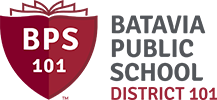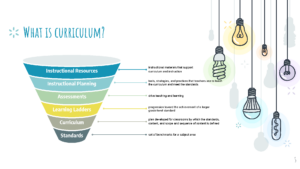Batavia Public School District 101
What is the Curriculum?
Discussions about curriculum, instruction, and assessment are some of the most important education conversations in a community. However, we often approach the term “curriculum” from different perspectives and understandings. Below is a brief synopsis of the different layers of the “curriculum.”
Put simply, standards are a set of benchmarks for a subject area. Depending on the standards, these can be designed by age, grade-level or degree of proficiency. Sets of standards are most often adopted by the State of Illinois, but we also see standards as a part of programs or courses that the local school district has adopted, such as standards for Advanced Placement classes that are set by the College Board or engineering classes whose standards are set by Project Lead the Way. For some subject-areas where the state or another outside agency has not selected the standards, the local district looks to regional or national standards for a benchmark of progress in that discipline. But, standards are not the curriculum.
Examples
Illinois Learning Standards
College Board Advanced Placement
Curriculum
The curriculum is based on the standards but the curriculum shapes those standards through what the district determines to be essential, important and “nice to know” (Ainsworth, 2003). Simply put, the curriculum is a plan developed for classrooms by which the standards, content, and scope and sequence of content is defined. While there are implied instructional practices and philosophies inherent in a curriculum, the curriculum addresses “what” will be taught.
Batavia Public Schools uses a review and design process for the curriculum that relies heavily on Understanding by Design (Wiggins & Tighe, 2005) to plan the curriculum and the essential questions for each segment of instruction. Teachers at all levels are directly involved in the curriculum development process.
Research Shows that there are several components to effective curriculum development:
Learning Ladders
A Learning Ladder is a set of statements sequenced as a progression toward the achievement of a larger grade-level standard. Learning Ladders are written as statements of the steps students need to evidence they have learned along the path to achieving the larger standard. The process of developing learning ladders allows for the educators to clarify what we want students to Know-Understand-Do (KUD). This process is also tied to PLC question #1–What is it that we want all students to be able to do?
Assessments
Assessment, in all its forms, is what drives teaching and learning. Pre-Assessments allow us to gauge what students need and how to differentiate to meet those needs. Formative assessment guides a teacher’s planning and grouping, and other forms of assessment allow us to determine what a student knows at different points in the teaching and learning process. Assessments may also let us know the health of the curriculum.
Unit Components
Effective units have been shown to have some essential components, including a hook, essential questions, enduring understandings, closure and feedback. Each of these components to curricular units is important to the learning process and students engagement and agency in this learning process.
Shared Strategies
An effective unit does not tell teachers what to do each day but has some common supports and experiences. Differentiation, when done well, is very difficult and requires support. A healthy curriculum provides resources to teachers in the process of differentiating the content, process, products and learning environment. In addition to differentiation support, an effective curriculum has shared experiences that foster common learning experiences that are rigorous, authentic, and standards-based.
Instructional Planning and Implementation
Instructional planning and implementation include the tools, strategies, and practices that teachers use to teach the curriculum and meet the standards. Instructional frameworks for each discipline provide a roadmap for this work and are based on what research and experience shows us is effective. Within the framework, there are a myriad of different strategies that teachers can employ in the learning process. These strategies are codified in teacher-created lesson plans that guide instruction in the classroom with the guidance of the curriculum. Lesson plans are one of the main ways teachers shape the experiences of the students in their classrooms. Lesson plans are not a list of activities for a single day but a learning progression designed to help a specific group of students in the teacher’s class reach the goals of the curriculum.
Often, educators talk about “best” practices, or those tools or strategies that yield consistent results for students. One best practice is small-group, differentiated instruction. This “best” practice has shown to yield consistent, positive results. This is one of many “best” practices that educators are discussing in their professional learning communities (PLCs). What drives these teacher-driven discussions are the results each instructional practice yields–this is the value of assessment, both formative and summative.
Instructional Resources
Often confused with the curriculum or instruction or even lesson plans, there are a host of instructional materials that support the curriculum and instruction. Textbooks, websites, manipulatives or any variety of supply can serve as an instructional material. Batavia Public Schools classifies instructional materials into three categories:
- Anchor–instructional material that all teachers and students will use. These are approved by the Board of Education
- Supplemental–instructional materials that have been selected by staff teams and are a part of a “bank” of resources for staff to use depending on the students and teaching environment.
- Responsive–instructional materials that are brought in by individual teachers in response to something in their class like a current event or by a student.
Instructional material are not the curriculum and are not the teacher’s instructional plan–but, these can be useful in facilitating the teaching and learning process.
The interplay of standards, curriculum, assessment, and instructional design is the work of a learning organization. There are many groups and individuals who are involved in this complex process. Below is a brief summary of the roles in this learning process:
Role of the School Board
The School Board is responsible for the curriculum of the school district. It approves curriculum and monitors the intended and achieved curriculum.
| Intended Curriculum | The content specified by the state or district to be addressed in a particular course or at a particular grade. |
| Achieved Curriculum | The content actually learned by students. |
(Marzano, 2003)
Role of the District
The District facilitates the development of curriculum by engaging staff in the process of reviewing, revising and monitoring the curriculum. The District also works to align resources with the curriculum.
Role of the Teacher
Teachers have a role in reviewing and revising the curriculum, but the main role of the teacher is in instructional planning and implementation. “How” the curriculum is implemented in the classroom is the role of the teacher. Teachers work to implement the curriculum using a student-centered pedagogy.
Gone are the days when this is the work of one teacher in his/her classroom. Instead, the complex work of teaching and learning is the responsibility of the teacher team.
| Student-centered pedagogy | In student-centered classrooms, students are directly involved and invested in the discovery of their own knowledge. Through collaboration and cooperation with others, students engage in experiential learning that is authentic, holistic, and challenging. Students are empowered to use prior knowledge to construct new learning. Through the development of the metacognitive process, students reflect on their thinking. Curriculum and assessment are centered on meaningful performances in real-world contexts. As a partner in learning, teachers intentionally create organized and cohesive experiences to assist students to make connections to key concepts. (taken from Iowa Core at iowacore.gov) |
Role of the Student
Students should have an active role in the teaching and learning process. Student ownership and active participation in the learning process is essential.
Role of the Parents/Guardians
Parents are experts in their child and can provide information to teachers about how to engage them in the learning process and how they are responding to instruction. Batavia Public Schools partners with parents to assist students in learning important skills that cannot be prioritized in our in-school learning time.




